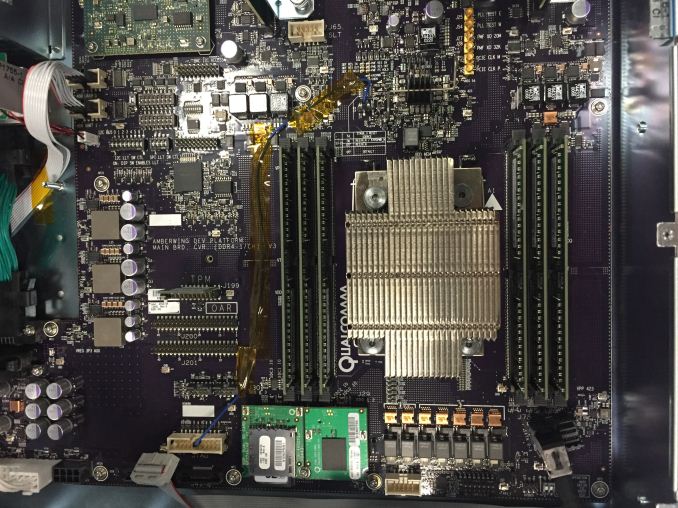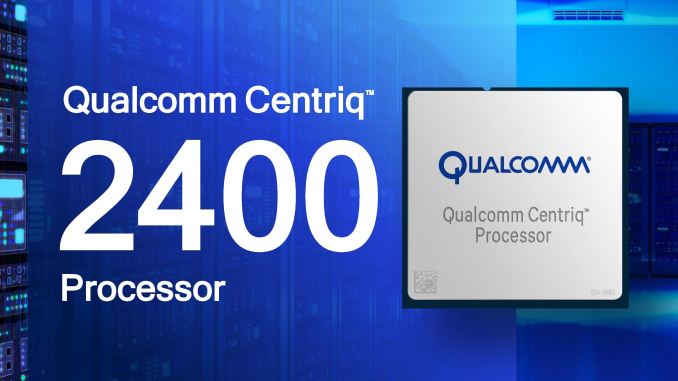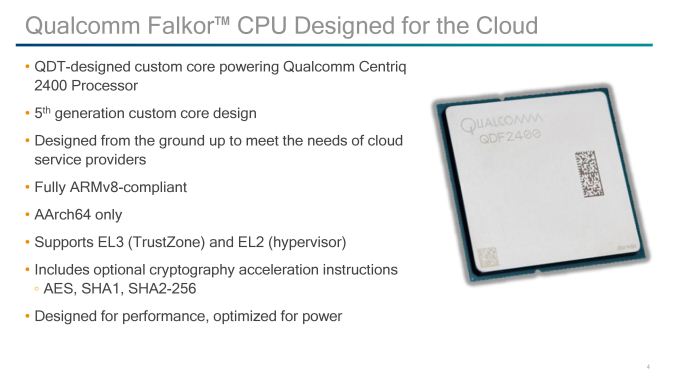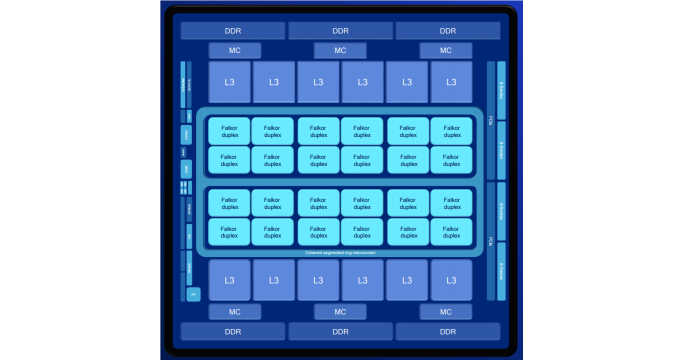Qualcomm’s Server Team Loses VP of Technology, Centriq Future Unknown
by Ian Cutress on July 6, 2018 2:00 PM EST- Posted in
- CPUs
- Qualcomm
- SoCs
- Enterprise CPUs
- Servers
- Centriq
- Centriq 2400

Normally we don’t particularly comment on these sorts of transitions at big companies unless they are C-level (CEO, CTO), however the narrative surrounding Qualcomm’s Centriq product line is still one that is perceived to be in flux. Qualcomm never commented on the rumors about its plans to find a buyer for Centriq, despite Axios and Bloomberg both reporting on them, and as a result never confirmed or denied the proposition: ultimately leading others to speculate. Followed by Anand Chandrasekher’s swift exit, again without public comment about reasons or replacement, and now another senior figure exiting the scene, brings more questions to the table than it answers.
The team behind Qualcomm Datacenter Technologies server platform, Qualcomm’s Centriq, has been in the news this past year as one of the key players in bring Arm architecture cores to the server and enterprise market. So far the time line looks like this:
- November 2014: Announced Plans to Enter Server Market
- December 2016: First 48-Core Demo and Sampling
- August 2017: Falkor Microarchitecture Detailed (Hot Chips)
- November 8th 2017: Cloudflare publishes integration testing
- November 10th 2017: Official Launch (for revenue) and Pricing
- May 8th 2018: Bloomberg Reports QDT may abandon Centriq
- May 13th 2018: Anand Chandrasekher, President of QDT, Leaves
- June 14th 2018: QDT Downsizing, 280 Jobs Cut
In 2017, Qualcomm announced the Centriq 2400 family of processors, built on Arm architecture cores at 10nm, for the enterprise and server market. This was meant to be the big break for Arm cores in the server market by a massive player that has the engineering staff and infrastructure to build a sizable customer base. The biggest version of the design implemented 48 of Qualcomm’s Falkor Arm v8 cores, paired with 60 MB of L3 cache, six channels of DDR4, running at a 2.2 GHz base frequency for 120W TDP and a price just shy of $2000: it was set to compete aggressively in the cloud server markets in performance per watt, overall performance, and cost. To date, Cloudflare has made the biggest noise about transitioning its DDoS protection platform from x86 to Centriq.

Qualcomm Centriq 'Amberwing' Development Platform, from Cloudflare
| Qualcomm Centriq 2400 Series | |||
| AnandTech.com | Centriq 2460 | Centriq 2452 | Centriq 2434 |
| Cores | 48 | 46 | 40 |
| Base Frequency | 2.2 GHz | 2.2 GHz | 2.3 GHz |
| Turbo Frequency | 2.6 GHz | 2.6 GHz | 2.5 GHz |
| L3 Cache | 60.0 MB | 57.5 MB | 50 MB |
| DDR4 | 6-Channel, DDR4-2667 | ||
| PCIe | 32 PCIe 3.0 | ||
| TDP | 120 W | 120 W | 110 W |
| Price | $1995 | $1373 | $888 |
However since the announcement, availability from the major server providers has been next to nil.
Back in May this year, almost at the same time as reports suggesting that Qualcomm was looking to offload (sell/close) the server processor division, Anand Chandrasekher left the company without much of a warning, at least publically, and aside from a personal tweet about leaving Qualcomm, no official note was given as to Anand’s replacement. The reports regarding the company offloading the server division were never confirmed, and behind the scenes several trusted sources reached out to AnandTech to say that this wasn’t really the case. Qualcomm has kept mum on the issue.
Fast forward to today, and another surprise hit our screens. One of the key members of the Falkor team, Dr. Dileep Bhandarkar, VP of Technology at Qualcomm Datacenter Technologies (QDT), seems to have parted from the company. Dileep was very much a key person for Falkor, purposefully spending time to track us down at Hot Chips after we published our detailed microarchitecture analysis and introduce us to the engineers, as well as chairing the Server Processor round of talks at the same event. The reasons for Dileep’s transition out of QDT are unknown. His departure was discovered due to his speaker biography for SemiCon West 2018 stating ‘formerly Qualcomm’.
Dr. Bhandarkar’s role is an important one here: he was a Director of Advanced Architecture at Intel for 12 years until 2007 (being a lead spokesperson for Intel’s server platform technologies), is an IEEE Life Fellow, has spent almost six years at Microsoft driving innovation and standards for its datacenters, and then a similar amount of time at Qualcomm working on technology strategy and business development, developing (among other things) machine learning accelerators currently in use at a major cloud provider. It would appear that rather than joining another industry behemoth, he is starting his own DNN based business.
So normally we don’t particularly comment on these sorts of transitions at big companies unless they are C-level (CEO, CTO), however the narrative surrounding Qualcomm’s Centriq product line is still one that is perceived to be in flux. Qualcomm never commented on the rumors about its plans for Centriq, despite Axios and Bloomberg both reporting on them, and as a result neither confirmed nor denied the proposition officially, ultimately leading others to speculate. Followed by Anand Chandrasekher’s swift exit, again without public comment about reasons or replacement, and now another senior figure exiting the scene, brings more questions to the table than it answers.
Whatever Qualcomm’s plans for Centriq have been, they seem to have stalled. It would appear that the product still does not seem to be available on the open market from the standard server manufacturers, and despite lots of talk citing the products wins over Xeon chips, nothing new has been said for quite a while. These OEMs are instead pushing Cavium’s ThunderX2 designs, which seem to have been gaining traction. Despite discussing with the Centriq team about being sampled for review in Q4 last year, that never materialized. Bloomberg also reported (via notices filed at a state level) a few weeks back that the company was cutting its datacenter unit in half, with up to 280 jobs on the line. It is possible that Dr. Bhandarkar's departure may have been one of these. The same report states that Qualcomm will continue its joint ventures in China, and rather than closing the unit will ‘persevere with a revised strategy’.
“Qualcomm remains committed to data-center opportunities and is not divesting the assets,” Amon said to Bloomberg. “We are reducing our investments in the data-center business but remain committed to our China JV and to refocusing our R&D efforts for upcoming compute opportunities.”
Source: SemiCon West













34 Comments
View All Comments
Quantumz0d - Friday, July 6, 2018 - link
Its a shame, during the Broadcom hostile takeover Jacobs and Steve were pressured by the Shareholders on how their current business model was better than that of the Tan's mountain farmer strategy which pays off well but only focuses on the short term benefits.EEtimes rick mentioned how that failed strategy was and how their M&A scene is destroying the innovation. Apple was to be enjoying highest benefits if that deal went through, glad that it fell off I cannot imagine Snapdragon processors without CAF, which is what I guess would happen once Broadcom gets hold of their SD platform.
But the jury is out, Jacobs left the company, they are releasing the 845 Source so late excusing the leak of the 6xx and 7xx platform in the code. The Centriq was the showcase of the Qcomms strategy of long term benefits and they had great progress, guess that's the reason why 835 and 845 don't have full custom core uarch like Kryo from 82x..and the recent trade war and dependency on China's MOFCOM for the NXP deal and how Huawei grips them for the 5G game. Ironically US govt loves M&A game with strong WallSt backing for Tan. But couldn't proceed due the Penetration of PRC - clue is Danhua Capital. And the latest news of CFIUS extension of reach bill.
Qualcomm is cornered and feeling the heat, thus they had to deal with Samsung again for their fabrication and manufacturing. And not to forget the blaze from Apple's predatory practice of shutting the small frys slowly (GTAdvanced, Imagination Tech)..
Let's see how it pans out..
Quantumz0d - Friday, July 6, 2018 - link
Edit - The reason of 835, 845 not having is because they moved a lot of uarch engineering to this Centriq division for temporary.iwod - Friday, July 6, 2018 - link
>And not to forget the blaze from Apple's predatory practice of shutting the small frys slowly (GTAdvanced, Imagination Tech)..Both results were their own making
GTAdvanced was basically a company that wanted Apple business not matter what, even though they knew, according to their knowledge technically impossible.
Imagination Tech : No one uses PowerVR, they felt asleep for far too long. Drivers on Linux, Android were barely adequate. Bought MIPS which was idiotic, their wireless department were not performing, and did not even bother trying to get MediaTek on board after Apple has made the move.
Jacobs's move were more to do with taking the company private. It was mentioned as better for National Securities and Interest. And he is doing it while starting his own company XCom.
I am still now sure, or see a clear way how this Apple and Qualcomm turns out. It seems silly to reduce its IP price just for Apple. But I also don't see Qualcomm lower its IP prices as it has market wide implications. Qualcomm CEO said it should be resolved within 6 - 9 months time. I am waiting to see this.
peevee - Friday, July 6, 2018 - link
What is "Tan's mountain farmer strategy "?Quantumz0d - Sunday, July 8, 2018 - link
https://www.eetimes.com/author.asp?section_id=36&a...Read the last paragraph of Page 1.
Yojimbo - Saturday, July 7, 2018 - link
Huh? You're trying to blame the failure of Centriq on Broadcom? Cornered and feeling the heat and so had to deal with Samsung? What are you talking about? What's Imagination Technologies have to do with server chips? Even in mobile GPUs, how is Qualcomm hurt by the loss of a competitor? Or are we supposed to interpret Qualcomm as a "small fry"? Qualcomm has been a bigger bully than Apple.Qualcomm's core competency is cellular technology. They are the best in the world at it. They muscled their way into the mobile SOC business through their cellular IP. But they had no way to similarly muscle their way into the data center. It's not Broadcom's fault there isn't great interest in their server chips. Breaking into the server market is hard.
Raqia - Friday, July 6, 2018 - link
This had been on his LinkedIn since March: https://www.linkedin.com/in/dileep-bhandarkar-a724...HStewart - Friday, July 6, 2018 - link
On the include link it states "He was previously Distinguished Engineer at Microsoft,"Well not sure if he was involved with Microsoft Windows on ARM at Qualcomm, but it could be that this is sign that Microsoft Windows on ARM is going to be huge failure.
Ian Cutress - Friday, July 6, 2018 - link
He was purely server at QCT.HStewart - Friday, July 6, 2018 - link
One interesting a wild thought, this is so soon after Intel's CEO leaving - but I don't believe this guy has the qualifications of replacing the CEO at Intel.